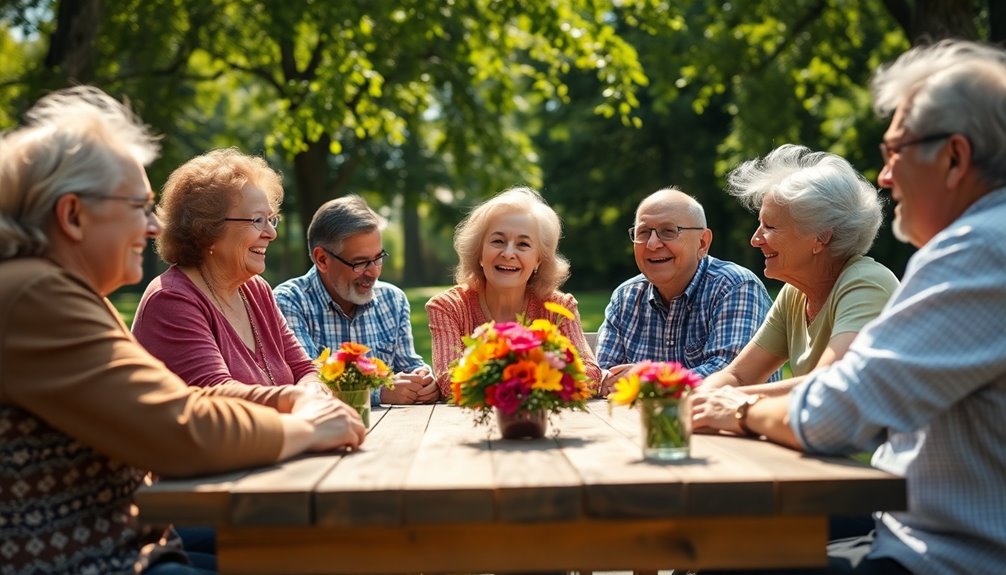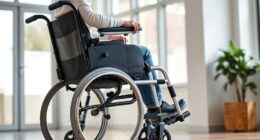To transform your golden years, embrace regular exercise like chair yoga, swimming, and cycling. These activities boost your mood, improve stability, and enhance mobility while reducing your risk of chronic diseases. Aim for at least 150 minutes of cardiovascular workouts each week, combined with strength training twice weekly. You’ll find that staying active not only keeps you healthy but also social. Keep going to discover more tips for optimizing your fitness journey!
Key Takeaways
- Incorporate regular cardiovascular activities like walking or swimming for at least 150 minutes weekly to boost heart health and energy levels.
- Engage in strength training twice a week with exercises like wall push-ups to maintain muscle mass and enhance overall functional fitness.
- Practice balance exercises such as heel-to-toe walking three times a week to reduce fall risks and improve stability.
- Include mobility exercises daily to enhance flexibility, ease stiffness, and promote independence in daily tasks.
- Join community fitness programs or classes to stay motivated and foster social interactions while exercising.
The Health Benefits of Exercise for Seniors

As you age, staying active becomes vital for maintaining your health and well-being. The health benefits of exercise for seniors are numerous and impactful.
Regular physical activity can markedly reduce your risk of chronic diseases like heart disease and diabetes, promoting a longer, healthier life. You’ll also notice an increase in energy levels and mood, thanks to the endorphins released during exercise. Additionally, engaging in regular exercise can help manage dementia medications and their side effects, allowing for a more balanced overall health approach. Furthermore, the practice of emergency preparedness through physical fitness can enhance your ability to respond to unforeseen challenges. Regular exercise also contributes to a budget plan for healthcare by potentially reducing medical expenses related to chronic conditions. Notably, maintaining physical activity is crucial for overall health in seniors.
Regular exercise significantly lowers the risk of chronic diseases, boosts energy, and enhances mood through the powerful effects of endorphins.
Engaging in workouts helps improve balance, coordination, and stability, reducing the risk of falls by 23%. This enhancement is essential for maintaining your independence.
Additionally, consistent exercise fosters better sleep quality and alleviates joint pain, contributing to an overall improved quality of life. Incorporating educational toys into your routine can also enhance cognitive stimulation and keep your mind active.
Embrace exercise to thrive during your golden years!
Importance of Regular Exercise Frequency

Regular exercise is essential for maintaining your health as you age. The CDC suggests aiming for at least 150 minutes of moderate-intensity exercise weekly, along with muscle-strengthening activities twice a week.
Here are three reasons why frequency matters:
- Enhance Balance: Regular physical activity greatly improves your balance and coordination, cutting fall risk by up to 23%. Additionally, listening to classical music during workouts can enhance focus and concentration, making your exercise sessions more effective. Moreover, audiometric testing can help identify any hearing issues that may affect your exercise routine.
- Muscle Maintenance: Engaging in strength training helps preserve muscle mass and bone density.
- Emotional Well-being: Consistency in exercise encourages social engagement and boosts your mood. Additionally, creating a supportive living space can further enhance your ability to stay active and engaged.
Recommended Exercises for Seniors
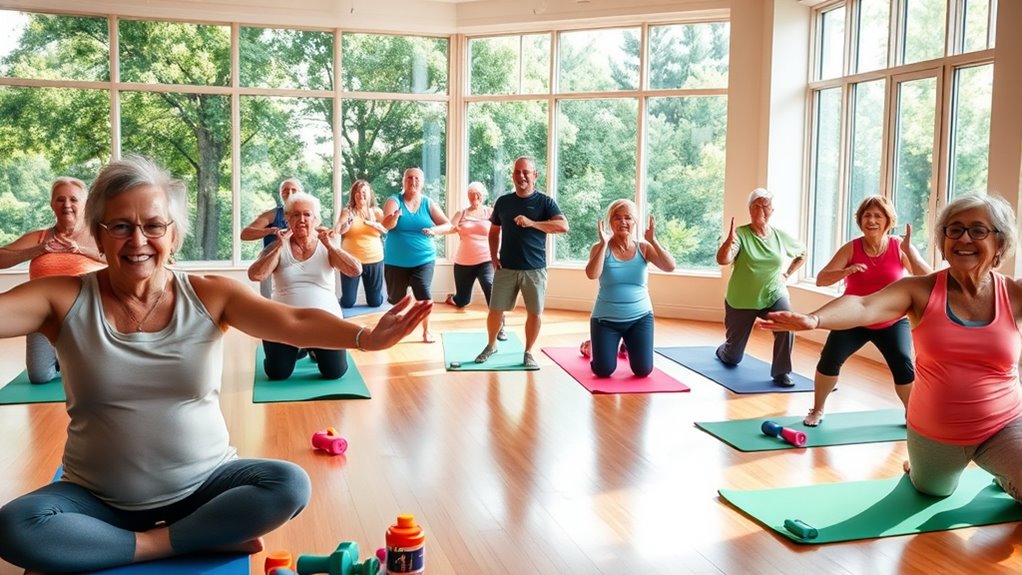
Engaging in the right exercises can make a significant difference in your overall health and well-being as you age. Here are some recommended exercises for seniors that focus on strength, flexibility, and cardiovascular health:
| Exercise | Benefits |
|---|---|
| Chair Yoga | Enhances strength and flexibility |
| Cycling | Gentle cardiovascular workout |
| Strength Training (2x/week) | Maintains muscle mass and bone density |
| Swimming/Water Aerobics | Full-body workout with minimal stress |
Incorporating these exercises into your routine will not only keep you active but also improve your quality of life. Regular physical activity can also lead to improved mental clarity as you age. Additionally, protecting your skin during outdoor activities is also essential as you age. Make sure to include at least two days of strength training each week to maximize benefits. Community events offered by organizations like Comfort a Life can provide motivation and support to stay active. Engaging in outdoor activities can also enhance your overall health benefits through fresh air and natural surroundings. Your journey to a healthier, stronger you starts now! Furthermore, engaging in physical activity can positively influence emotional and psychological growth as you navigate your golden years.
Enhancing Balance and Stability

Enhancing your balance and stability is essential for staying active and independent as you age.
By incorporating effective stability exercises into your routine, you can greatly reduce the risk of falls and injuries. Engaging in regular physical activity not only strengthens your muscles but also helps to reduce anxiety, which can improve overall mobility. Additionally, maintaining a stable routine and clear rules for children can also contribute to a more balanced life, as it fosters a sense of security. Engaging in regular physical activity can be likened to the diverse tent camping locations found in New England, as both promote a connection to the outdoors and enhance overall well-being. Furthermore, incorporating social interaction into your daily activities can provide mental stimulation that further supports your balance. Let’s explore some simple daily practices that can boost your confidence and improve your overall mobility. Additionally, engaging in activities that promote emotional well-being can further enhance your balance and stability as you age.
Importance of Balance Training
While you may not realize it, balance training plays an essential role in reducing the risk of falls, which impact one in four older Americans each year. Home improvement strategies can also help create a safer living environment for seniors. Additionally, incorporating watering techniques for houseplants in your home can improve air quality, contributing to a healthier living space. Creating a clutter-free environment can further enhance emotional well-being, allowing seniors to focus on their balance exercises without distractions.
By incorporating balance exercises into your routine, you can greatly enhance your stability and coordination. Here are three key benefits of balance training:
- Reduced Fall Risk: Engaging in balance activities can lead to a 23% decrease in falls, promoting safety.
- Improved Mobility: Regular balance exercises boost your confidence, encouraging you to stay active in daily life.
- Enhanced Independence: Strengthening your balance supports maintaining independence as you age.
Additionally, maintaining emotional regulation through physical activity can further support overall well-being as you navigate the aging process.
Make sure to practice balance exercises, like heel-to-toe walking, three times a week to effectively improve your stability and reduce the risk of falls.
Effective Stability Exercises
Balance training is just the beginning when it comes to improving stability as you age. Regular balance exercises can reduce your risk of falls by 23%, enhancing your confidence and mobility.
Simple activities, like walking heel-to-toe or standing up from a seated position, strengthen your core and boost overall balance. Aim to incorporate these exercises three times a week to support your physical stability and independence in daily life.
Tools like wobble boards or joining fall prevention programs can further enhance your balance and minimize injury risk. Plus, these exercises can alleviate joint pain, allowing you to move more freely and comfortably.
Prioritize effective stability exercises to transform your golden years into a time of strength and wellness.
Daily Balance Practices
Incorporating daily balance practices into your routine can greatly boost your stability and confidence. Engaging in balance training at least three times a week can greatly reduce your risk of falls.
Here are a few effective exercises to keep in mind:
- Heel-to-Toe Walk: This simple movement enhances coordination and stability, making everyday activities safer.
- Stand Up from a Seated Position: Practicing this builds core strength and balance, essential for your independence.
- Wobble Board Exercises: Use a wobble board to challenge your stability and improve proprioception.
Participating in fall prevention programs that focus on balance and strength can further enhance your physical safety and self-sufficiency.
Start incorporating these practices today to maintain your independence and confidence!
Strength Training Essentials
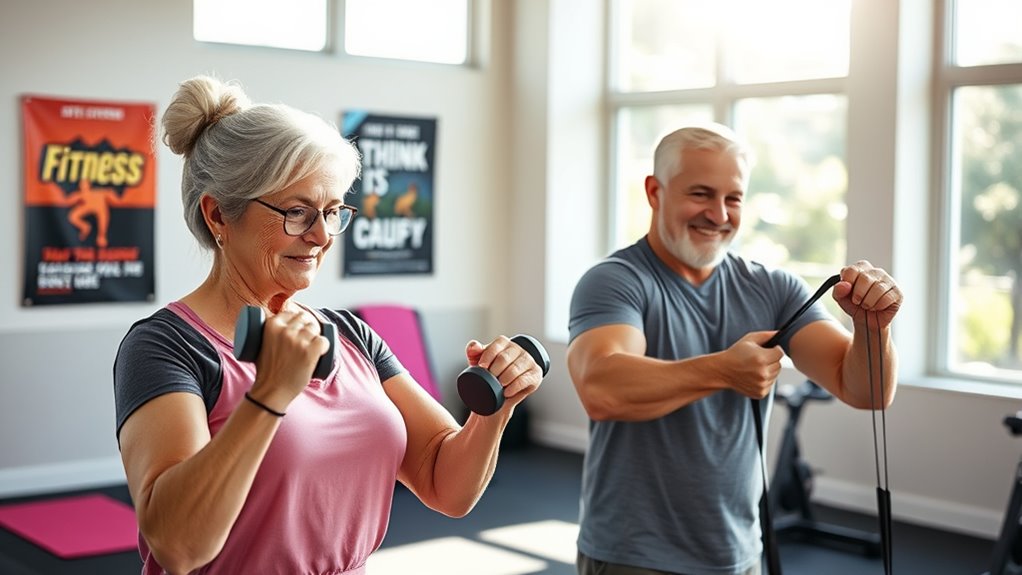
Strength training is essential for seniors, as it helps maintain muscle mass and bone density important for overall health.
By engaging in strength training at least two days a week, you can enhance your functional fitness, making daily activities easier and promoting independence.
Bodyweight exercises like wall push-ups and calf raises are effective and safe options that improve muscle strength without heavy weights.
Research shows that regular strength training also reduces the risk of falls by enhancing balance and stability, crucial for maintaining mobility.
Additionally, it contributes to better metabolic health, aiding in the management of chronic conditions such as diabetes and heart disease, which are common among seniors.
Embrace strength training to enjoy a healthier, more active lifestyle!
Engaging in Low-Impact Activities

Engaging in low-impact activities can greatly benefit your overall health while being gentle on your joints.
Popular exercises like swimming, cycling, and chair yoga not only enhance strength and flexibility but also improve your cardiovascular fitness.
Benefits of Low-Impact Activities
While you may think that high-intensity workouts are the best way to stay fit, low-impact activities offer numerous benefits, especially for seniors.
These gentle yet effective exercises can greatly enhance your health and wellness. Here are three key benefits:
- Joint-Friendly: Low-impact activities like swimming and cycling minimize stress on your joints, making them ideal for maintaining mobility and flexibility.
- Strength and Density: Regular participation helps maintain muscle strength and bone density, essential for preventing conditions like osteoporosis.
- Social Engagement: Many low-impact workouts are social, fostering connections that can boost your emotional health and overall well-being.
Popular Low-Impact Exercises
If you’re looking to stay active without putting too much strain on your body, there are plenty of popular low-impact exercises to choose from. Activities like swimming, cycling, and chair yoga can boost your cardiovascular health and improve strength. Walking and water aerobics are fantastic for enhancing endurance, while balance training like heel-to-toe walking helps prevent falls. These low-impact exercises not only keep you fit but also support your mental health by releasing endorphins that elevate your mood.
| Exercise | Benefits | Mental Health Impact |
|---|---|---|
| Swimming | Cardiovascular health | Reduces anxiety |
| Chair Yoga | Flexibility & strength | Boosts mood |
| Water Aerobics | Endurance & energy | Improves overall wellbeing |
Cardiovascular Exercises for Heart Health
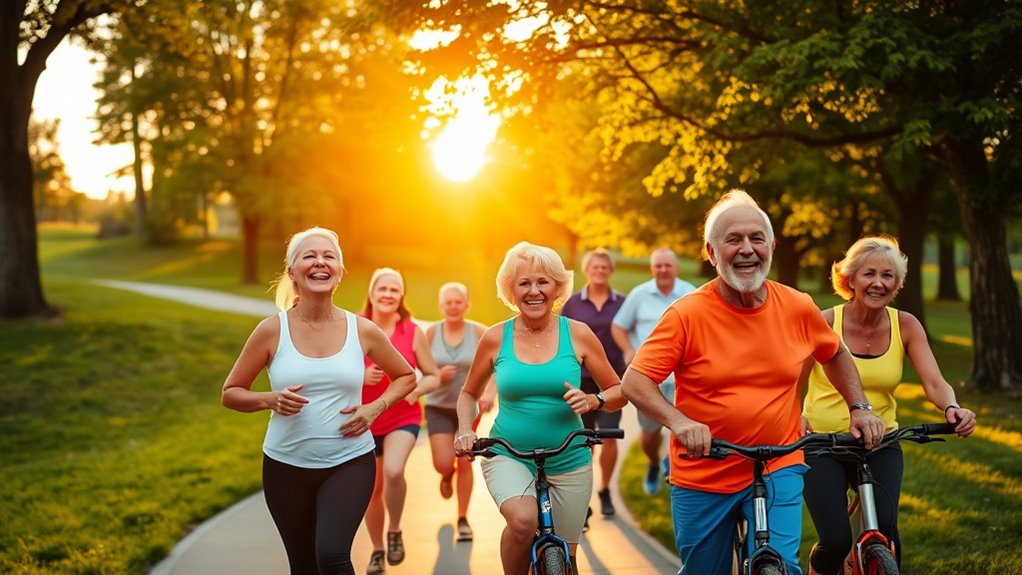
Cardiovascular exercises play an essential role in maintaining heart health as you age, especially when you aim for at least 150 minutes of activity each week.
Engaging in regular cardio not only promotes cardiovascular health but also boosts your energy and endurance. Here are three effective options to evaluate:
Regular cardio not only enhances heart health but also increases your energy and endurance levels.
- Walking: A simple yet powerful exercise that can be done anywhere.
- Swimming: This low-impact activity is gentle on joints while delivering a solid heart workout.
- Group Activities: Join a community walking group or play pickleball to combine social engagement with exercise.
Incorporating these activities into your routine can enhance oxygen delivery to your muscles.
Plus, they help maintain joint health and keep loneliness at bay!
Mobility Exercises to Maintain Flexibility

Maintaining flexibility is essential as you age, helping to prevent stiffness and improve your overall mobility.
By incorporating a daily routine of mobility exercises, you’ll enhance your range of motion and make everyday tasks easier.
Simple stretching techniques can boost your posture and energy levels, contributing to your overall well-being.
Importance of Flexibility
Flexibility is essential for seniors, as it not only helps maintain independence but also plays an important role in preventing injuries.
Regular mobility exercises enhance flexibility, which improves balance and coordination, reducing the risk of falls. Here are three key benefits of incorporating mobility exercises into your routine:
- Joint Health: Gentle stretching routines, like neck stretches and ankle circles, improve joint mobility and reduce stiffness.
- Pain Relief: Consistent mobility work can alleviate discomfort from conditions like arthritis, promoting overall joint functionality.
- Energy Boost: Spending just a few minutes daily on mobility exercises can increase energy levels and enhance physical performance in daily activities.
Daily Mobility Routine
Incorporating a daily mobility routine can greatly enhance your overall well-being as you age. Mobility exercises, like neck stretches, shoulder rolls, and ankle circles, are simple yet effective movements you can do daily to maintain flexibility and improve joint health.
Just a few minutes of these exercises can combat stiffness and boost your range of motion, particularly in key areas like your hips, shoulders, and knees. By including a variety of mobility exercises that target different muscle groups, you’ll not only promote balance and stability but also reduce your risk of falls.
Consistency in this routine supports not just your physical health but also mental clarity and emotional well-being, contributing to a fulfilling active lifestyle.
Stretching Techniques Benefits
As you age, embracing stretching techniques can greatly boost your flexibility and overall mobility.
Regular mobility exercises are essential for maintaining independence and performing daily activities. Here are three benefits you’ll enjoy from incorporating these techniques:
- Improved Joint Health: Gentle stretching reduces stiffness and enhances range of motion, helping you move more freely.
- Reduced Pain and Discomfort: Consistent mobility exercises can alleviate chronic pain, improving your overall quality of life.
- Enhanced Balance: Stretching boosts circulation and supports muscle recovery, ultimately reducing your risk of falls.
Aim for a few minutes of mobility exercises each day.
Exercises Seniors Should Avoid
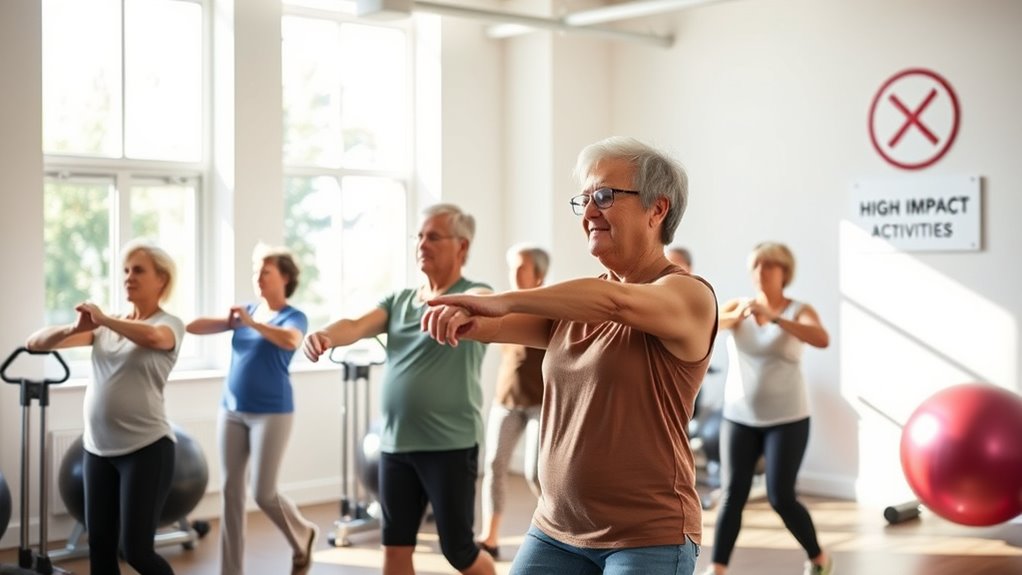
While staying active is essential for seniors, certain exercises can pose risks that outweigh their benefits. High-impact activities like running or jumping increase the risk of injury and falls, especially due to decreased bone density and joint health.
You should also be cautious with exercises that require significant balance or coordination, such as advanced yoga poses, as your balance may decline with age. Heavy weightlifting, including deadlifts and heavy squats, can strain joints and worsen existing health conditions.
High-intensity interval training (HIIT) might lead to excessive fatigue and injuries; it’s safer to focus on moderate-intensity activities. Finally, avoid exercises that strain your joints, like abdominal crunches, to help reduce discomfort and keep you active longer.
Resources for Staying Active and Informed

To stay active and informed, you can tap into a variety of resources designed specifically for seniors. Here are three essential options to take into account:
- PF App: Access free resources like 5-Minute Low-Impact Cardio and 15-Minute Mobility sessions to help you stay fit.
- Community Programs: Join local organizations offering fall prevention classes and group fitness sessions, which also promote social interaction.
- Online Platforms: Explore workout videos that cater to all fitness levels, making it easier to incorporate activity into your routine.
Don’t forget to consult with a healthcare provider to develop a tailored exercise plan that fits your health conditions.
These resources for staying active and informed will empower you to maintain your fitness and well-being!
Frequently Asked Questions
What Is the Number One Exercise for Seniors?
The number one exercise for seniors is walking.
It’s a low-impact activity that you can easily adapt to your fitness level. Just walking for 30 minutes a day can boost your energy, improve cardiovascular health, and enhance your balance, reducing the risk of falls.
Plus, it’s a great way to socialize if you join a walking group, which can also benefit your mental well-being.
What Is the Number 1 Exercise to Increase Balance in Seniors?
Improving your balance is like building a strong foundation for a house; without it, everything else might crumble.
The number one exercise to enhance balance in seniors is practicing standing up from a seated position. This simple move strengthens your core and lower body, greatly boosting your stability.
What Is the AARP #1 Exercise for Seniors?
The AARP’s number one exercise for seniors is walking. It’s accessible, low-impact, and offers numerous health benefits.
You should aim for at least 150 minutes of walking each week to boost your cardiovascular health, manage your weight, and improve your mood.
Plus, regular walking helps maintain your mobility and independence, reducing the risk of falls.
Joining a walking group can also enhance your social interactions, making it a great way to stay connected.
What Is the Best Exercise to Lose Belly Fat for Seniors?
To lose belly fat as a senior, you should focus on a mix of strength training and cardiovascular exercises.
Incorporate core workouts like seated leg lifts and chair squats to build muscle, which boosts your metabolism. Pair this with activities like brisk walking or swimming for at least 150 minutes a week.
Don’t forget to include balance exercises, as they enhance stability and support your overall fitness, helping you achieve your goals effectively.
Conclusion
Staying active during your golden years isn’t just about adding years to your life; it’s about adding life to your years. By incorporating regular exercise into your routine, you’ll boost your strength, enhance your balance, and improve your heart health. Whether you’re lifting weights, enjoying a brisk walk, or practicing gentle stretches, each movement counts. So, embrace this journey, stay informed, and remember: every step you take brings you closer to a healthier, happier you.

